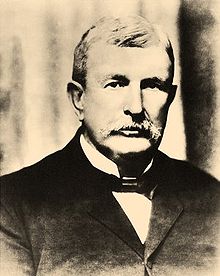Benjamin Holt
| Benjamin Leroy Holt | |
|---|---|

Benjamin Leroy Holt
|
|
| Born |
January 1, 1849 Concord, New Hampshire |
| Died | December 5, 1920 (aged 71) |
| Nationality | American |
| Occupation | President of Holt Manufacturing Company |
| Known for | Patented and manufactured first workable continuous tracked tractor, led to Caterpillar Inc. |
| Spouse(s) | Anna Brown |
| Children | Alfred B. Holt, William Knox Holt, Anne Holt, Edison Ames Holt, Benjamin Dean Holt |
| Signature | |
 |
|
Benjamin Leroy Holt (January 1, 1849 – December 5, 1920) was an American inventor who patented and manufactured the first practical crawler-type tread tractor. The continuous-type track is used for heavy agricultural and engineering vehicles to spread the weight over a large area to prevent the vehicle from sinking into soft ground. He founded with his brothers the Holt Manufacturing Company.
Holt was the youngest of four brothers and eleven siblings, the children of William Knox Holt and first, Eliza Jane Virgin, and later Harriet Parker Ames of Concord, New Hampshire. William Knox Holt owned a sawmill that made hardwood for wagon and coach construction. In 1864, Benjamin's brother Charles H. Holt arrived in San Francisco, California where he founded C. H. Holt and Co. The company produced wooden wheels for wagons and, later on, steel streetcar wheels. Brothers William Harrison Holt and Ames Frank Holt arrived in 1871. The company sold hardwood, lumber, wagon and carriage materials, primarily manufacturing wagon axles, wheels, and frames. The brothers shipped hardwood from New Hampshire by ship to San Francisco.
In 1869, Benjamin went to work in his father's sawmill, readying hardwoods for shipping to his brothers in San Francisco. At age 23, he was given an interest in the business, and he managed shipping the lumber to the west coast. His mother died in 1875 and his father died eight years later in 1883. With his parents gone, Holt left for California as well.
Benjamin Holt arrived in California in 1883. The Holt brothers formed the Stockton Wheel Company to season woods in a way that would prepare them for use in the arid valleys of California and deserts of the West. They based their new venture in the warm Central Valley town of , where the climate was suitable for drying wooden wheels. They invested $65,000 into a factory equipped with the best machinery available. Stockton, about 90 miles (140 km) east of San Francisco, was accessible by seagoing ship and riverboat via the San Joaquin River. By 1883 the brothers had 25 men on the payroll in a three-story brick building and a one-story wood frame building in Stockton.
Benjamin was acknowledged by his family as an entrepreneurial and mechanical genius. Most of the surrounding fields were recovered from the delta of the San Joaquin River. Much of it was planted in wheat and Benjamin Holt produced his first horse-drawn "Link-Belt Combined Harvester." This machine used flexible chain belts rather than gears to transmit power from the ground wheels to the working mechanism, reducing breakage and down time. While manufacturing coach and wagon wheels and carriage bodies, Benjamin saw a need for mechanical Traction engines to replace horse-drawn machinery.
...
Wikipedia
